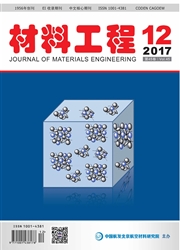

 中文摘要:
中文摘要:
对钛微合金化TRIP钢进行连续冷却转变曲线的测定,分析轧制与冷却工艺对其组织与性能的影响。结果表明:实验钢的奥氏体/铁素体、奥氏体/马氏体相变点分别在500~650℃和450℃左右;组织由铁素体/贝氏体及少量残余奥氏体组成;随着终轧温度的升高,实验钢的屈服强度和抗拉强度有所降低;随着空冷结束温度的降低,实验钢的屈服强度降低;当终轧温度和空冷结束温度分别为796℃和722℃时,实验钢的屈服强度,抗拉强度和强塑积分别为661,888MPa和25042MPa·%,其对应组织为细小的铁素体及板条贝氏体,铁素体基体上存在大量细小的析出物。
 英文摘要:
英文摘要:
A Ti-microalloyed TRIP steel was selected, and the continuous cooling transformation curve was measured. The microstructures and mechanical properties of steels were investigated at different rolling and cooling processes. The results show that the austenite/ferrite and austenite/martensite transformation temperature are at about 500-650℃ and 450℃, respectively. The microstructure of steel is composed of ferrite/bainite and a small amount of retained austenite. The yield strength and tensile strength of steel decrease with the increasing of finish rolling temperature. The yield strength of steel decreases with the decreasing of air cooling end temperature. When the finish roiling and air cooling end temperature are 796℃ and 722℃, respectively, and the yield strength, tensile strength and the product of strength and elongation of the steel are 661, 888MPa and 25042MPa.%, respec- tively. The microstructure is consisted of fine ferrite and lath bainite,and a large number of fine pre- cipitates presents on the ferrite matrix.
 同期刊论文项目
同期刊论文项目
 同项目期刊论文
同项目期刊论文
 期刊信息
期刊信息
